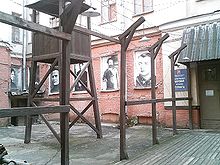Gulag Museum
The Gulag Museum ( Russian: Музей ГУЛАГа ), officially the “State Museum of the History of the Gulag ” (Russian: Государственный музей истории ГУЛАГа ), is a state museum in Moscow on the history of the system of Soviet prisoners and forced labor camps in 1930 - until the 1950s.
Emergence
The museum was founded in 2001 by Anton Wladimirowitsch Antonow-Ovsejenko (1920–2013), a famous dissident in Russia and author of the work “ Stalin : Portrait of a Tyranny”, who was himself imprisoned in Stalin labor camps from 1940 to 1953. The exhibition opened in 2004. In addition to the presentation of the Gulag system, it is also dedicated to researching the political, administrative and economic functions of this system in the Soviet Union. It is now managed by the founder's long-time deputy, Roman Wladimirowitsch Romanow. It opened on October 31, 2015 at a new location at 1. Samotetschnyj-Gasse 9 (Russian: 1й Самотечный пер., Д. 9 ) with four times the exhibition space than before.
exhibition
One focus of the exhibition is the exemplary presentation of the personal fates of individual of the estimated 15 to 18 million people who fell victim to the Gulag system between 1934 and 1960. Letters and mementos, personal belongings and works of art created in the camps by former Gulag inmates are also shown. Video installations with testimonies from former prisoners as well as current works of art on the subject complement the exhibits. Furthermore, copies of official documents as well as replicas of a prison barrack, a detention cell and a watchtower from a camp are shown. The museum also has a document archive.
activities
The museum, together with other museums and archives, private collectors, painters, photographers and contemporary artists, organizes both permanent and traveling exhibitions in Moscow and other cities. It regularly organizes conferences, seminars and lectures on recent research on the history of the Gulag and its interpretation. It organizes concerts, readings, book presentations and theatrical performances, takes part in the Moscow Long Night of Museums and shows Russian and international films on the subject. It also participates in field trips to places of Gulag, for example in the notorious for its forced labor camps Oblast Magadan , in part, helping with special commemorative places like the Ermordungs- and burial place " Kommunarka " of the NKVD in the southwest of Moscow, where, according to the FSB about 6,500 victims of the Great Terror currently known by name and an unknown number not known by name are buried.
location
The museum is located approx. 3 kilometers north of Red Square in 1. Samotechnyj-Gasse 9, house 1. The nearest metro stations are Dostojewskaja and Novoslobodskaja . The museum is open every day except Mondays from 12 p.m. to 9 p.m. Entry is free.
Exhibition selection
- 2015: “Christmas in the GULAG”, exhibition on the various attempts by camp inmates to celebrate the forbidden Christmas; Video room , video performances with the results of the MyGULag project , in which interviews with former inmates, their relatives and descendants as well as former guards were linked to films, photos and other contemporary documents from the mid-20th century; Commemoration of the 1959 Tibet Uprising .
- 2014: “I was alone and against all odds…”, exhibition of works by Valentin Mitrofanow; "Repressed Buddhism", exhibition on the suppression of Buddhism in the Soviet Union; "Between Worlds. Vadim Sidur and His Work ”, exhibition on the life and work of the artist; "Life Line", video art presentation on the reception of the past; “Trials: 70 Years After”, exhibition on the expulsion of the Ingush in World War II.
- 2013: "I came as a guest in your country. German anti-fascists in the Soviet Union 1933–1956 ”, exhibition on the fate of German emigrants in the Soviet Union in the 1930s; “Without the Tsar…”, exhibition in collaboration with the Novospassky Monastery in memory of 400 years of the Romanov dynasty; " Trotsky . The Commissar Returns ”, exhibition of photos from the David King collection ; "Presentation of a new collection of Varlam Shalamov’s works in 7 volumes", book presentation; “ Kharms- concert”, concert; " Karl Eimermacher . Under Protection - Unprotected ”, exhibition with works by the German historian and Slavist.
- 2012: “The Commissar Vanishes. The Falsification of Photographs and Art in Stalin's Era ”, exhibition of photos from the David King collection ; “Live Sound”, concert.
- 2011: “ZONE. Uranium camps of Chukot “, exhibition of photos from the uranium mining areas in the Far East.
Web links
- Museum website (Russian and English)
Individual evidence
- ^ Michael Schwirtz: Anton Antonov-Ovseyenko, Who Exposed Stalin Terror, Dies at 93. In: The New York Times. July 10, 2013. Retrieved October 7, 2014.
- ↑ a b c ( Page no longer available , search in web archives: About the Museum. ) Accessed October 1, 2014.
- ↑ ( Page no longer available , search in web archives: The concept of development of the Museum of Gulag. ) Retrieved October 6, 2014.
- ↑ ( Page no longer available , search in web archives: GULAG History Museum opens in the new building October 21, 2015. ) Retrieved on November 2, 2015.
- ↑ a b ( Page no longer available , search in web archives: Science and research works in Magadan region. ) Retrieved on October 6, 2014.
- ^ Gulag museum to create camp 3D models. In: TASS Russian News Agency. August 12, 2014. Retrieved October 7, 2014.
- ↑ ( Page no longer available , search in web archives: Volunteer Day on Saturday, October 11, 2014, October 3, 2014. ) Retrieved on November 4, 2014.
Coordinates: 55 ° 46 ′ 37.5 ″ N , 37 ° 36 ′ 49.2 ″ E
